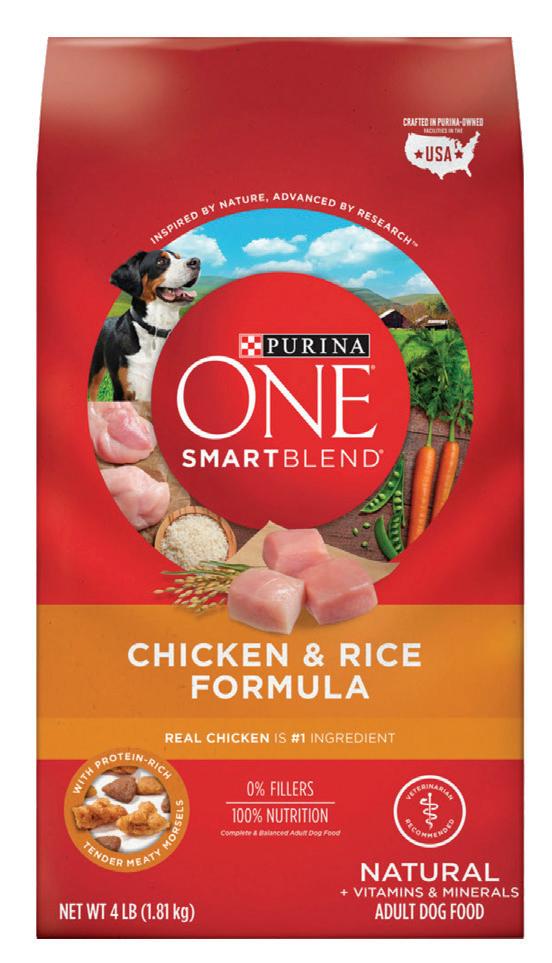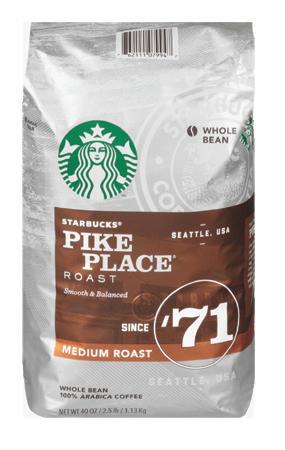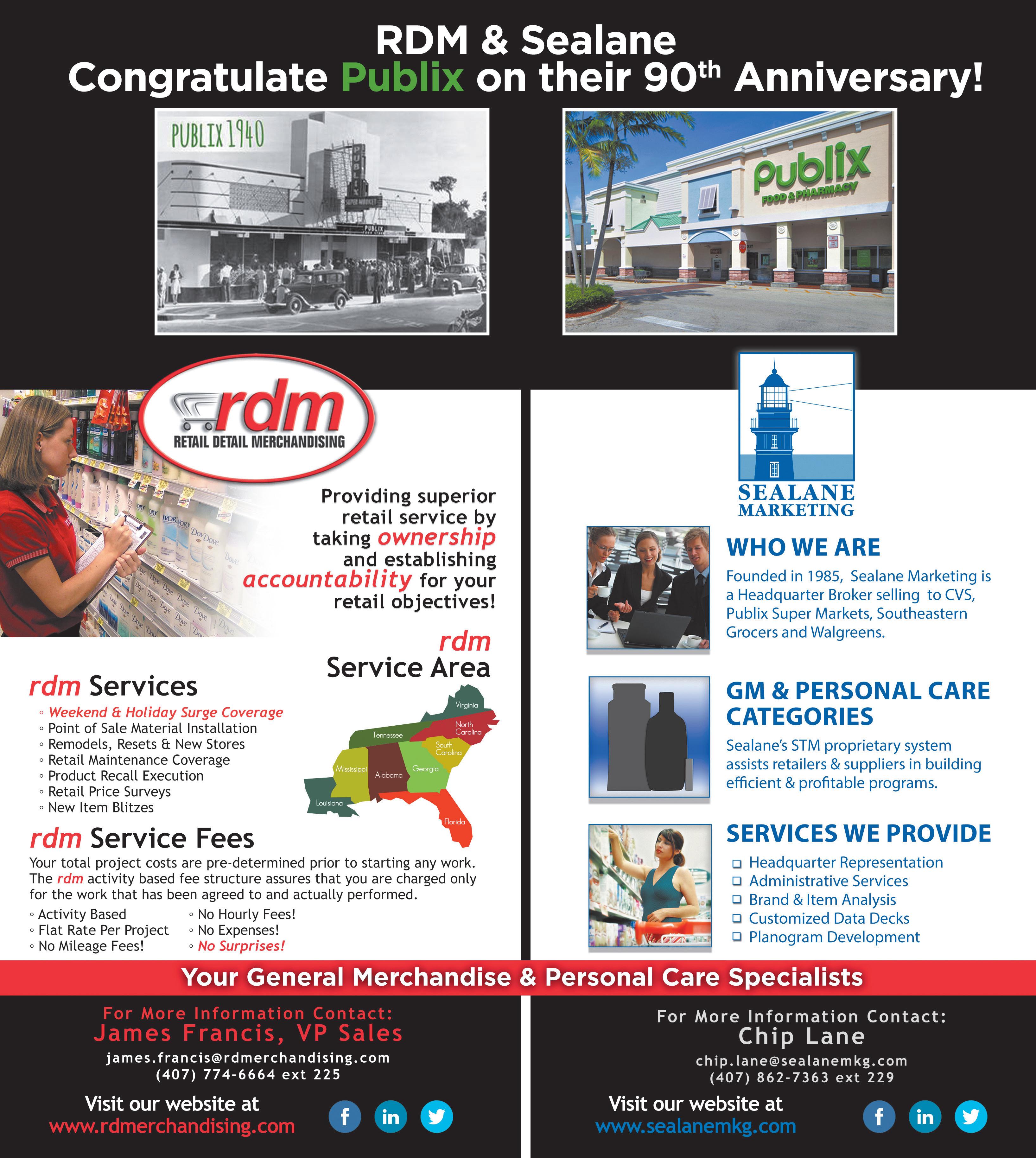
















This year marks Publix’s 90th anniversary. In addition, the company has been named The Shelby Report’s 2020 Southeast Retailer of the Year.

During a recent visit to the Lakeland, Florida-company’s home state, Shelby Publishing President and Publisher Stephanie Reid and Editor in Chief Kevin Atwill visited with Todd Jones, Publix CEO, and other company officials.
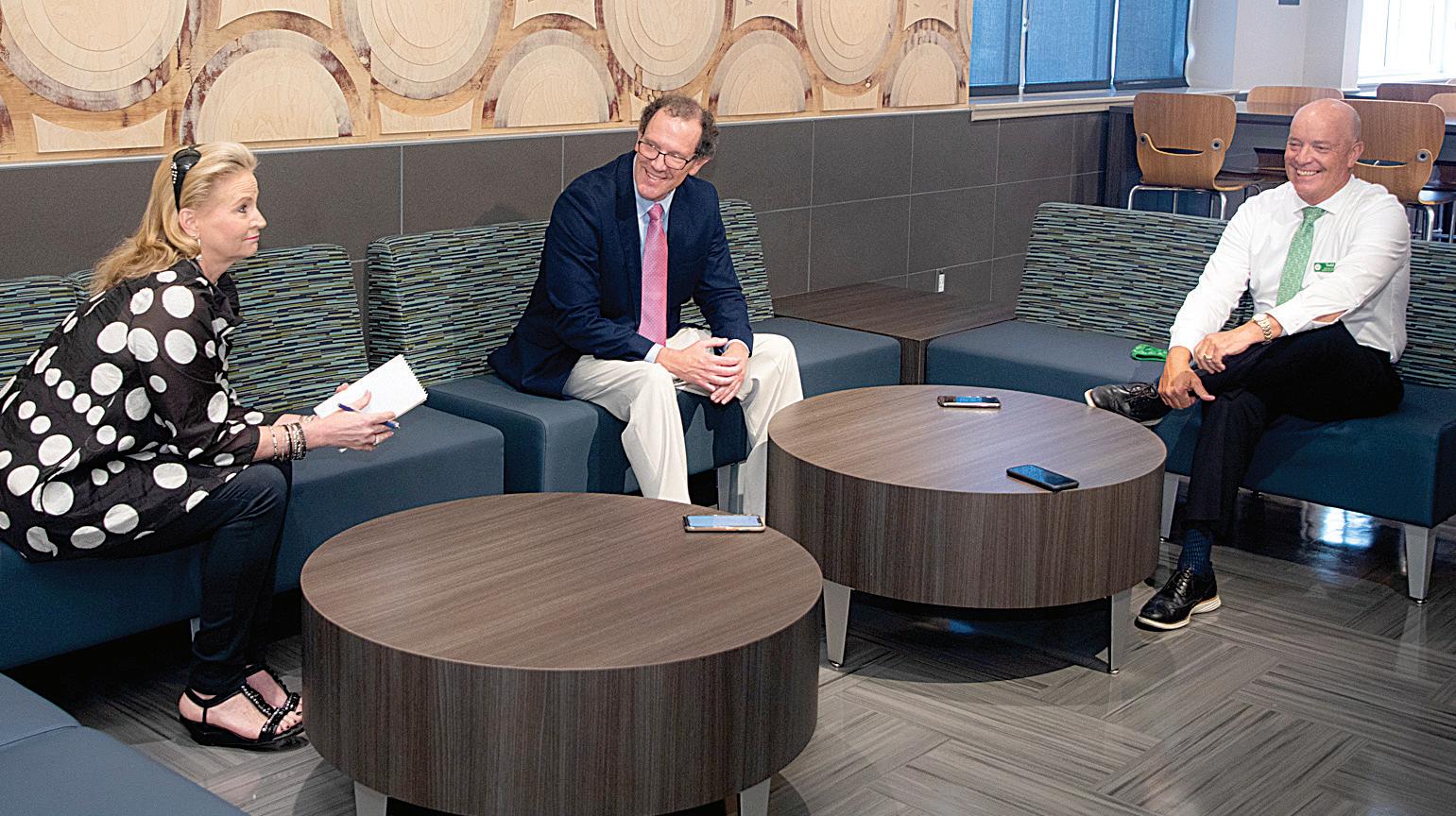
Todd Jones is the first non-family member to serve as CEO of Publix. He succeeded Ed Crenshaw, the grandson of founder George Jenkins who is chairman of the company, in 2016.
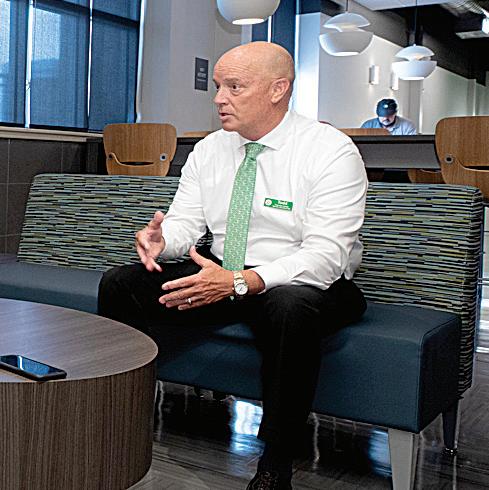
Jones began the conversation with the Shelby Publishing team by reflecting on his relationship with his predecessor.
“Having the opportunity to work with Ed is probably is the best experience anybody could ever have,” Jones said. “You’re working with somebody that’s so rich in the culture and the fabric of the organization that it was just an amazing time. I still work with him today, obviously, as chairman, but it really helped out.
“It really helps to bring to life his grandfather’s vision of his company. Some of the harder conversations, he would always say, “Sit down, Todd, we need to talk. I knew what that was going to mean.”
Though he’s been at the helm for several years, Jones is quick to say it’s an ongoing process.
“The transition has been good,” he said. “It’s been a lot of work, but [it helps] having a lot of great people, a lot of Publix people who have spent a lot of time with the company. [Some] have also worked either with Mr. George, around Mr. George, with Ed, with Howard Jenkins, with Charlie Jenkins Jr. – some of those great leaders that have helped position Publix, up to five years ago.
“When I first took on the role, I was kind of dual-roling it as CEO and president. We’ve recently promoted a president, Kevin Murphy, into that role. It’s been a little bit of a transition.”
As part of that transition, Jones said his perspective has undergone a slight change.
“You walk into a store, or you walk into an area, and now we’re thinking about the business a little bit differently,” he explained. “Is it just operations? Is it strategic long range? Before you’re doing your evaluation in your own mind, am I evaluating myself as the president, am I evaluating myself as the CEO?
“So that’s been a nice transition, because it really helps solidify how you think about the business a little bit.”
Turning to an overview of the company, Jones marveled at the fabric and longevity of Publix’s team.
“We have 225,000 associates,” he said. “I think the average tenure for our store managers is 25 years. We’ve got 1,250 store managers, and that average is 25 years for that group itself.
“We have a running list of the longest years of service with the organization. And that list is 2,000 people long. And if you don’t have probably 36 years, you don’t make the list. We’re very proud of that.”
And Jones himself would make that list, as he has more than 40 years with Publix, starting at age 15 as a bagger at a store in New Smyrna Beach, Florida.
“I’m very proud of what Mr. George started, with the vision of a company of ownership, with the vision of a company of promotion from within an opportunity and inclusive organization back in 1930,” he said. “And we’ve done our best to continue to carry that vision forward and take good care of our most important asset – our associates, who in turn will take care of the customer.”
Jones then reflected on some wisdom imparted by the company’s late founder.
“I’ll tell the story about Mr. George, when he was once asked how much he would be worth today had he not given so much away. His response immediately was ‘probably nothing.’ George Jenkins knew the importance of how a strong community would build a strong company.
“Mr. George always believed in giving back your time, your talent and your treasure. And we continue to carry that forward, making sure that our communities that we operate in are in as good of condition as we can make them by giving back into those organizations.”
Turning to the future, Jones outlined his vision for the next five years.
“Fun, very fun,” he said. “We get to get up every day. We get to work with each other as
a functional team, which is built on trust, having a relationship with your partners within the company that you can really have good dialogue and have healthy conflict. It’s not about personal conflict. It’s about solving the issues that the company is trying to solve.
“In the next five years, we’ll continue to build on that momentum of, ‘One Publix, One Purpose,’ and carrying that mantra moving forward.”
The second item on the horizon will be sustained growth, according to Jones.
“Our company is a growth company, and we want to continue to grow,” he said. “We have about 23 net new stores that we’ll have this year – 30 total, with seven that will be replaced. We’ll probably have about 25 net new stores next year if everything works as planned.” While there may not be any new market areas in Publix’s three-year real estate plan, Jones said the company would add “a lot of new stores.”
“We’re going to continue to grow the stores,” he said. “We also remodel a lot of stores every year. So it’s not just a matter of opening new stores, it’s taking this concept, and then remodel the store – figuring out how we take this concept and put it into a store that’s 30 years old. And that’s an interesting dynamic to try to figure out how you do that.”
And growth is not limited to facilities and stores.
“We’ll have a lot of time spent on developing people,” Jones said. “We get to have that great opportunity to develop people and watch them grow and carry the company forward. And so that’ll be the next five years’ efforts, to continue to develop on the genesis of this organization.”
Philanthropy also will remain at the forefront for Publix.
“We’re going to keep giving back to the community, more than we ever have, as far as trying to help solve food insecurity,” he said. “We do a lot of other things. But that really is – for us, for me – a big point. We’re in the food business, and I don’t think there’s anything we should be doing more than to help figure out how we can help solve that – doing our part on that.”
Jones acknowledged that technology can be wonderful, but said Publix will take a measured approach.
“We’re going to constantly change as fast as we can and as fast as we need to, but not unnecessarily,” Jones said. “There are some things with technology that we’ve got to be really careful about. It looks nice and looks fun – it looks interesting on the outside – but when you dig into it, the practical application of that might not be there.
“We’ll do everything we can to leverage technology where it makes sense for the company.”
Prior to the COVID-19 pandemic, Publix had an existing partnership with Instacart, a delivery and pickup service, which has only strengthened over the past nine months.
“I think, for us, one of the things that I like to think about for Publix is that there’s complementors in this business that you need to leverage. And Instacart happened to be one of those,” Jones said. “It had a really strong skill set, it matched well with our skill set, and we were able to get together and figure out how that may work as a unit of one.
“We will continue to leverage each other’s technical expertise, continue to leverage each other’s value proposition and make it a better one.
“But we have other complementors that we have in the store as well, like Boar’s Head. They’re an extremely important business partner for Publix, and they help us and we help them. It makes it a better experience for our customers.”
You probably know how to bake your own cobblers and pot pies, but Great American Cobbler Company makes it so easy for you to make any family meal extra special. All our products are handcrafted with all-natural ingredients, including 100 percent American grown fruit. From our Family Farm to your Table.




Great American Cobbler Company is farmer-owned and operated. We’ve been growing fruit for generations and we’re applying the same passion for quality in growing fruit to baking our products. Our production facility is located in South Georgia, and we’ll be creating jobs right where we farm. We’re excited to be positively impacting our rural communities.
Americans of all ages want tasty, easy, and healthy foods to enjoy at home. Great American Cobbler Company’s cobblers and pot pies are timeless classics that are sure to please. They’re a great value too. With Great American Cobblers and Pot Pies, you’ll save time and effort, and get guaranteed results, every time. info@greatamericancobblercompany.com
 Handcrafted Apple Cobbler Sweet Buttery Crumble
Handcrafted Blackberry Cobbler Sweet Buttery Crumble
Handcrafted Blueberry Cobbler Sweet Buttery Crumble
Handcrafted Peach Cobbler Sweet Buttery Crumble
Handcrafted Apple Cobbler Sweet Buttery Crumble
Handcrafted Blackberry Cobbler Sweet Buttery Crumble
Handcrafted Blueberry Cobbler Sweet Buttery Crumble
Handcrafted Peach Cobbler Sweet Buttery Crumble
No aspect of the supermarket industry has been untouched by COVID-19, and Publix is no exception. To CEO Todd Jones, the pandemic’s legacy likely will be felt for years.
“What’s interesting is, I think we’ll [continue using] terminology that we’ve never used in our entire past,” he said. “I mean, who knew what ‘social distancing’ even was seven or eight months ago? And while I think we’ll transition back to where there’ll be large groups of people back together again, I think that’ll still be a term that’s used moving forward.”
One significant result of social distancing has been a shift in shopping behavior. More customers are opting out of the in-store experience.
“I think that we’ll see the delivery business, or curbside business, [which] obviously moved up pretty quick, continue to grow,” Jones said. “In a short period of time, it probably grew faster than we had anticipated. While I think it’ll come back down to some degree, I don’t think it’ll go back to where it was.
“I still see more people utilize that service. They feel a little more comfortable when they don’t want to be in an environment around a lot of people.”
The supply chain certainly felt the effects of the pandemic.
“The supply chain is one that we all need to step back from, and we all need to figure out how disruption within the supply chain can really put us and our customers in a place that we don’t want to be at,” Jones said.
“I don’t know that we’ll be able to solve that in a short period of time, because when you’re looking at rebuilding manufacturing facilities and warehouses and distribution centers, those take a bit of time to be able to put into place and to solve that. But it’s something that we’re all working on, having the conversations with our business partners to figure out how we can solve those peaks when they rush up like they do.”
Peaks can be common in the industry, particularly in hurricane-battered Florida, but COVID has had a sustained impact.
“This one’s been a peak, and it’s been there for a while, it’s been months,” Jones said. “I would tell you going back to 2004, the weather events had the same similar behavior from the consumer, but they were a lot shorter periods. They would go up and come back down, unless there was a damaged area,
and then those go up and stay for a period of time.
“When we had a bad weather event right behind [Hurricane Hanna] in Texas not too long ago, we had similar supply chain issues when just two large states within the United States were draining inventory, trying to recover from those. It took probably three or four months to get our supply chain back in place again, to where I would like to see it for customers.”
Jones added that the supply chain could remain a little fragile for some time, as Publix and other grocers work to “understand how that fragileness could actually impact our customers. [It’s] something that we’re working on to make it a much better place long term.”
Another long-term issue likely will be SKU rationalization, or optimizing of inventory.
“Rationalization probably should stick around,” Jones said. “If you look across our store, and you know there’s 34,000 items on average out there right now, that’s probably similar to many of our competitors, somewhere in that range. And there’s
many of those items that are very low volume that might not warrant the overall responsibility to carry that product on the shelf today.
“I think there’ll be some SKU rationalization that will stick for a long period of time. Having said that, for Publix specifically, one of our value propositions is variety. So while we’ll have a smaller store footprint than many of our competitors, in just the size of the box, we still want to do everything we can to carry the product mix that the customer is looking for… because that’s what we do.
“We want to make sure that we take care of the customer, so we’re working hard to get those items back in as fast as we can.”
As with many grocers, Publix has enjoyed a boost in center store during the pandemic.




“If you’re in an urban area versus not, we might have a little bit less center-store business and a little more frequency on
Please see page 22

From page 20
the outside of the store, but center-store is still doing well,” Jones said. “And certainly, COVID has boosted it back up a bit. It’ll be interesting to see if it falls back to pre-COVID volume, but we still do really well in the center of the store.”
He added that Publix has made some adjustments to that area of the store.
“It’s smaller than it’s been when I started stocking groceries. The store was capped in size, and 80 percent was center store and 20 percent was all other,” he said. “Today, it’s about 55 percent of our store and 45 percent is all other.”
Private label has been fairly constant at Publix this year.
“There hasn’t been a significant change in private brand versus our business partners’ branded products,” Jones said. “We haven’t seen a significant shift in that.”
When it comes to inventory, the CEO said all of Publix’s stores are on a company-run automated replenishment system.



“All of it’s on a perpetual inventory,” he said. “We’ve got a lot of calculations behind the scenes as far as shelf capacity, the shelf condition we want it to be in, truck deliveries…to give the store the best presentation possible for the customer. Produce is on the same system as well.
“[Perpetual inventory] helps on an allocation tool model. If you know the balance, you know when the stores are receiving it, you know the demand, you know their particular [setup] because we’ve got 1,250 stores. There are 50 unique prototypes out there…it knows all of that and then it knows what the actual balance is, so it knows how to allocate it.”
As an example, Jones offered a scenario where 600 stores are slated to receive toilet paper.
“How can I best allocate those 600 stores based on what they have on hand? [The system] does the best it can to allocate the existing inventory when there are shortages,” he said. “We deal with that all the time in produce…you might want 10 loads of berries, and there’s only eight available, so now your allocations will have to kick into drive.”
As the pandemic continues, conversations with fellow industry players, as well as customers, also will be key.
“Most of [the dialogue] is with the trade associations that we work with, and we spend a lot of time listening to the customer,” Jones said. “Our marketing team, on a much more frequent basis than they have in the past, is constantly asking those customers, what’s the next thing that you’re looking for? What has changed in your life now that this impact has taken place?
“I would want to get more information there than I would on the other side, at least initially, then work on the processes.
“I always like to say, put the C’s before the P’s. Put the customers before the processes. We set up our business model to do that on a regular basis.”
Maria Brous, director of communications for Publix, added that feedback from associates also will help shape the postpandemic path.
“Part of what we tasked all of the officers with was actually going into the departments – what has worked well during the pandemic? What’s changed? What can we improve on?
Internally, we’re working on that, too,” she said. “We’re kind of taking care of the inside or infrastructure of what’s happening with our own associates and departments working together.
“How do we, in this temporary norm, try to figure all of that out? I think the associates and the customers have come before the processes trying to figure that out.”

A recent product of Publix’s generosity is the Farmers and Family initiative.



Through the effort, Publix bought fresh produce and milk to assist farmers impacted by the COVID-19 pandemic. The company then donated these products directly to Feeding America member food banks in its operating area.


The initiative began with Florida produce farmers, Southeastern dairy farmers and the growing number of families looking to Feeding America for fresh fruits, vegetables and milk. At the time it was announced in April, Publix CEO Todd Jones said the company was grateful for the chance to help.






“As a food retailer, we have the unique opportunity to bridge the gap between the needs of families and farmers impacted by the coronavirus pandemic,” he said.
According to Feeding America, an estimated 17.1 million additional people experienced food insecurity due to school closures and rising unemployment during the pandemic.
“Publix understands that more families are turning to us to help put food, especially fresh

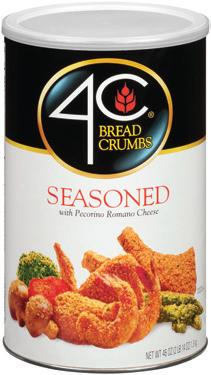
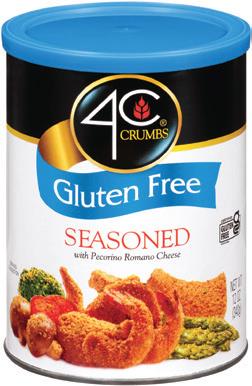


produce and milk, on their tables,” said Feeding South Florida President and CEO Paco Velez. “We’re grateful to Publix for not only supporting growers, but also for their years of support of Feeding South Florida.”
With numerous reports of farmers discarding produce and milk that isn’t being sold – mostly as a result of school, restaurant and hotel closures – Publix helped address the needs of both the farming community and its local partner food banks through this initiative.

“We are thrilled about Publix’s initiative to buy additional milk from Southeast Milk for processing and donation to Feeding America member food banks,” said Southeast Milk Inc. President Joe Wright. “It’s a win-win for our farmers who are feeling the impact of decreased demand and the families who are in need of nutrient rich milk during this pandemic.”
The effort has since expanded to include Publix’s entire seven-state coverage area. Reflecting on the effort six months later, Jones praised the efforts of the grocer’s team and its partners.
“Farmers and Family is something I’m extremely proud of – of the team and how it evolved and how it’s come to life,” he said. “Right at the very beginning…literally within the first day or two when
Please see page 26


From page 24
COVID-19 really started to increase in concern within the country and outside of the country, I received a text from one of our stateelected officials. It was a picture on a farm of four semi-loads of raw milk, with the valves open, just dumping it on the ground.
“And we just knew that we needed to figure something out to try to help because the total consumption of food was probably pretty constant. It just shifted from one side of a business to another – the school systems or the travel industry – in places that weren’t using it.”
Jones went on to note that Publix assembled a team to address the issue.
“We got our produce team involved in it because we were hearing and seeing a lot of produce, as well as milk, being tilled under. About 10 days later, we had our Farmers and Family program in place.”
Jones went on to offer an update on the program as of October.
“Within the last week or two, we’re probably at 13 million pounds of produce that we’ve pushed back out into the marketplace for the customers in our area, and 5,000 or 6,000 gallons of milk,” he said. “It’s been a great program and very rewarding to see it going in the right places.”
“We’ve got a lot of great people with the right mindset to do the right thing – to take care of the communities we operate in.”
Throughout the company’s history, Publix has supported organizations working toward alleviating hunger in its neighborhoods. Since 2009, Publix has donated more than $2 billion in food to people in need and has pledged an additional $2 billion in food donations over the next 10 years.

Since August, Publix has received six separate honors from various publications and organizations, ranging from Forbes and Fortune to Newsweek and People magazines.

The Lakeland, Florida-based grocery giant is being hailed for everything from its customer service and philanthropy to offering a work environment that appeals to women, new graduates and Millennials.
According to Publix CEO Todd Jones, the accolades are a reflection of the company’s culture.
“What we believe is that, because of the touch side of the business, the emotional side of the business, of creating a culture of an organization, there needs to be a lot of art,” he said. “It has to be a lot of art. A lot of feel for that. It's not all science behind it.
“I also think that you can build science or processes in the minds carrying forward culture. You have to establish it first. What is a culture? A culture for us is treating our customers like royalty…that's part of our customer-facing culture.”
According to Jones, associates are treated as the most important asset, internally and externally.
“I'm going to need you here,” he said of the company’s approach to an employee.
Please see page 28
Customer service is one of the hallmarks of Publix. It also is one of the areas for which the company is frequently honored. CEO Todd Jones (right) is quick to point out that the customer service desk is always easy for shoppers to find, usually situated to the front-right or front-front as they walk in.


The honor is great and so is Publix commitment to excellence. Your 90-year commitment to being the best are rooted in your family of more than 200,000 employees.
The Garner family is proud of our partnership for serving excellence in our Texas Pete® Hot Sauce and Green Mountain Gringo® Salsa brands.
Our shared roots as strong southern brands make us even stronger as we continue to bring the best in flavor to America.

From page 26
“I want to rely on you here, so I want to make sure there's an emotional connection that we have here. But I also need to make sure that I can sustain that and Publix can sustain that. So we created a mentoring program.
“What is a mentoring program? Well, we want to make sure that every leader within Publix has chosen a mentee, maybe two people, that they can work with throughout the year. We built a formal mentoring program, and we give them a toolbox. But then we let them actually make that toolbox work for them.”
Recognition also is important in fostering the culture.
“The longevity, whether it's a five-year, 10-year, 15-year recognition luncheon across the entire company,” said Jones, adding Publix may recognize 20,000 to 30,000 people annually for their years of service. “We take them to lunch, recognize them – or dinner, bring their family members in for a dinner.


“I think what you have to do is kind of define what that culture is, put a lot of art behind it. But don't
be afraid to throw the science side of the processes in, so that it's going to be something that's continuing through the organization on a regular basis.”
Consistency also is central to Publix’s culture.
“We’re celebrating 90 years this year, and we haven't had to redefine who we are,” said Maria Brous, director of communications. “It's been very simple for us from the beginning
to say we're focused on the customer. We’re focused on the dignity and respect and value of our associates. We haven't had to teach our culture over and over and over to redevelop that – it's been very consistent.
“It’s a consistent message each time. It's building the opportunity for advancement or promotion within company. There's lots of opportunities. When you hear about where people start and where they go, that's the culture…we create opportunity, and that's part of our culture.”
There’s also valuing the difference.
“We recognize that we have multi-generations that are working for us,” Brous said. “We start from age 14, and the eldest associate to date is 96. That is huge. How we communicate and how we keep them engaged, and how we share information, and how we value and get experiences that both Todd and Kevin always talk about.
“We want to keep close to the work – keeping close to the people who do the work, so that you can actually get that feedback, improve
processes, continue to put customers and associates first. That is the culture. It’s perpetuating that culture. It's incumbent on each of us to do that.”
Countless managers got their start with Publix as teenagers.

“We hope we never let our teams – at any level – not be able to lead at the level they need to lead,” Jones said. “Down low or up high or sideways, they’ve got to be able to lead in all those fashions. And if they can’t, we’ve got to get them back engaged into the game. Come back out and work. It's been a while since I've been a store manager, but I come out and engage in stores on a regular basis.”
All management and corporate personnel spend time in the stores each year.
“We're not asking them to understand how to mix dough,” Jones said. “But they ought to understand the process and the difficulties and challenges associated with mixing dough. Because you come in, you go back to bakery and the bread wall’s empty in the morning.
“There's a lot of science behind it. It could be 50 degrees outside, and the temperature just changed five degrees in your store, and the dough didn't work right.
Please see page 30

From
page
“You have to be able to adjust and fly on that and understand that and be able to coach and be there…if you can’t, I think that you'll end up out-running the coverage, and then they'll end up somewhere else.”
Jones doesn’t hide his pride in Publix associates and their accomplishments.
“I just can't tell you how proud I am of all these folks, what they’ve done – not only on a regular basis, but they’ve stepped up to another whole level,” he said.
And they inspire him in his role.
“The more responsibility you have, the more you have to listen to them. And I try my best to lead that way.
“We try to teach our team to go to the back of the house and talk to the associates long before you come out and talk to people. Bring them out and ask them why this worked this way or didn’t. You can manage front to back or back to front. Back to front is much better.”
The honors rolled in for Publix at a steady clip throughout the summer and fall – including twice in a span of five days in both August and September. The following is a brief look at each of the awards.
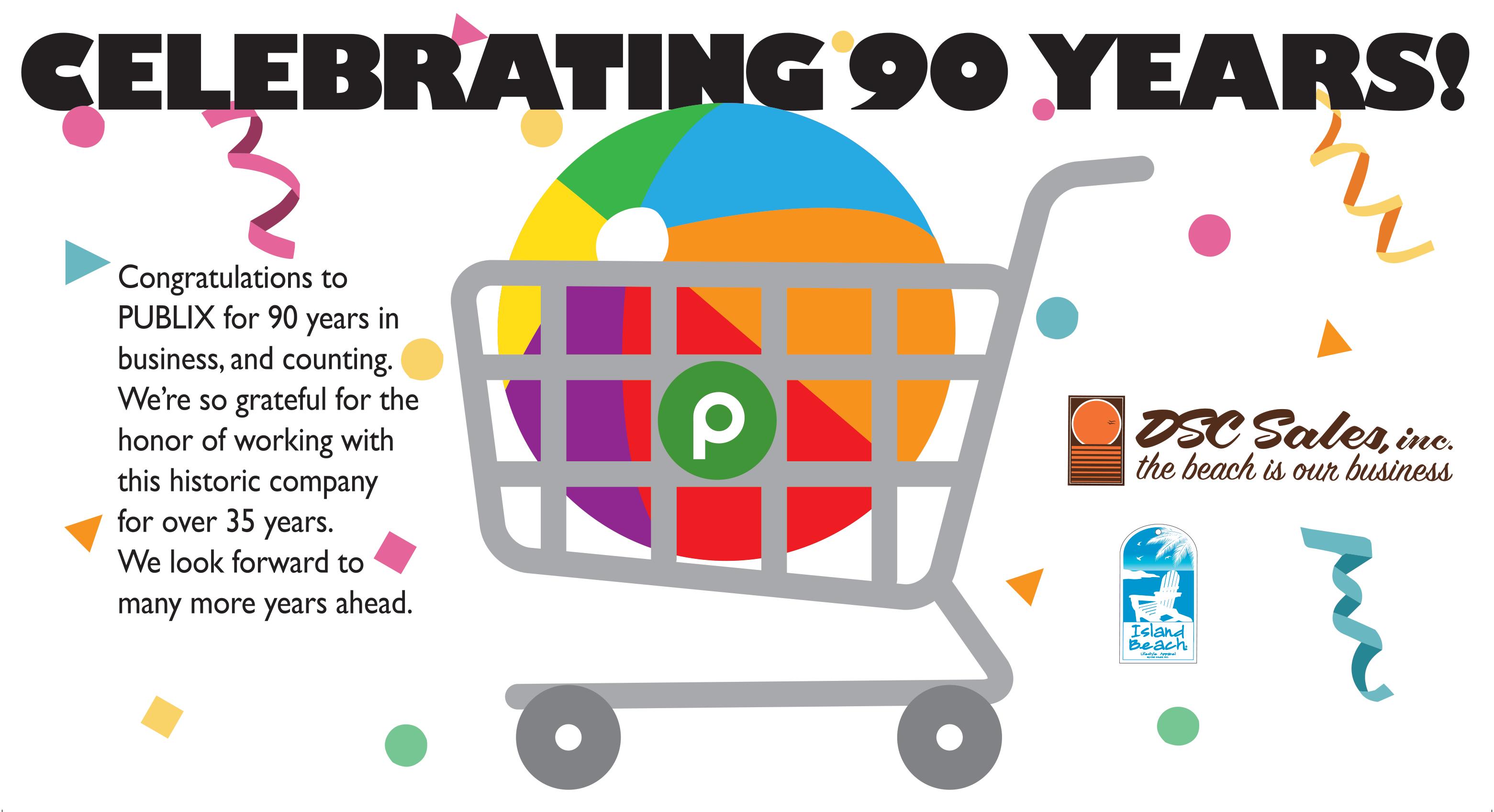
Oct. 15
Publix was named to Newsweek’s 2021 America’s Best Customer Service list, ranking No. 1 in the supermarket category.
“We are honored to be recognized with this award by our customers,” said Maria Brous, director of communications. “Publix associates work hard to treat our customers like royalty, and we’re grateful to be acknowledged for customer service excellence in our industry.”
More than 25,000 U.S. customers who have purchased, used or researched a product or service in the past three years were surveyed. The final assessment and rankings were based on how likely customers would be to recommend the companies to friends and family and their evaluation of the companies in the areas of quality of communications, professional competence, range of services, customer focus and accessibility.
The top three to five companies were ranked in each of 160 categories.
Sept. 21
Fortune recognized Publix as one of the Best Workplaces for Women, ranking No. 29 of 100 companies on the 2020 list.

“Our inclusion on the 2020 list reflects Publix’s commitment to create a diverse culture that makes us stronger as a company,” Brous said.
In a survey conducted by Great Place to Work, women were asked about experiences in their workplace based on their ability to reach their full potential and how their gender shapes those experiences. Great Place to Work then analyzed trends based on an organization’s size, industry and region.
Sept. 17
Forbes has ranked Publix No. 21 on its list of America’s Best Employers for New Grads 2020, up from No. 45 last year.
“Attracting and retaining top talent is a priority for us,” Brous said. “We are dedicated to developing and growing our associates at all stages of their careers and are honored to be
considered a top employer by new graduates.”
More than 20,000 U.S. young professionals – employees who have under 10 years of work experience – were asked in an independent survey to assess their employers according to atmosphere and development, image, working conditions, salary and wage, workplace and diversity.
They also were asked whether they would recommend their employer to others and then evaluated other employers in their respective industries that stood out either positively or negatively. Participants work for companies that employ at least 1,000 people within the U.S.
Sept. 3
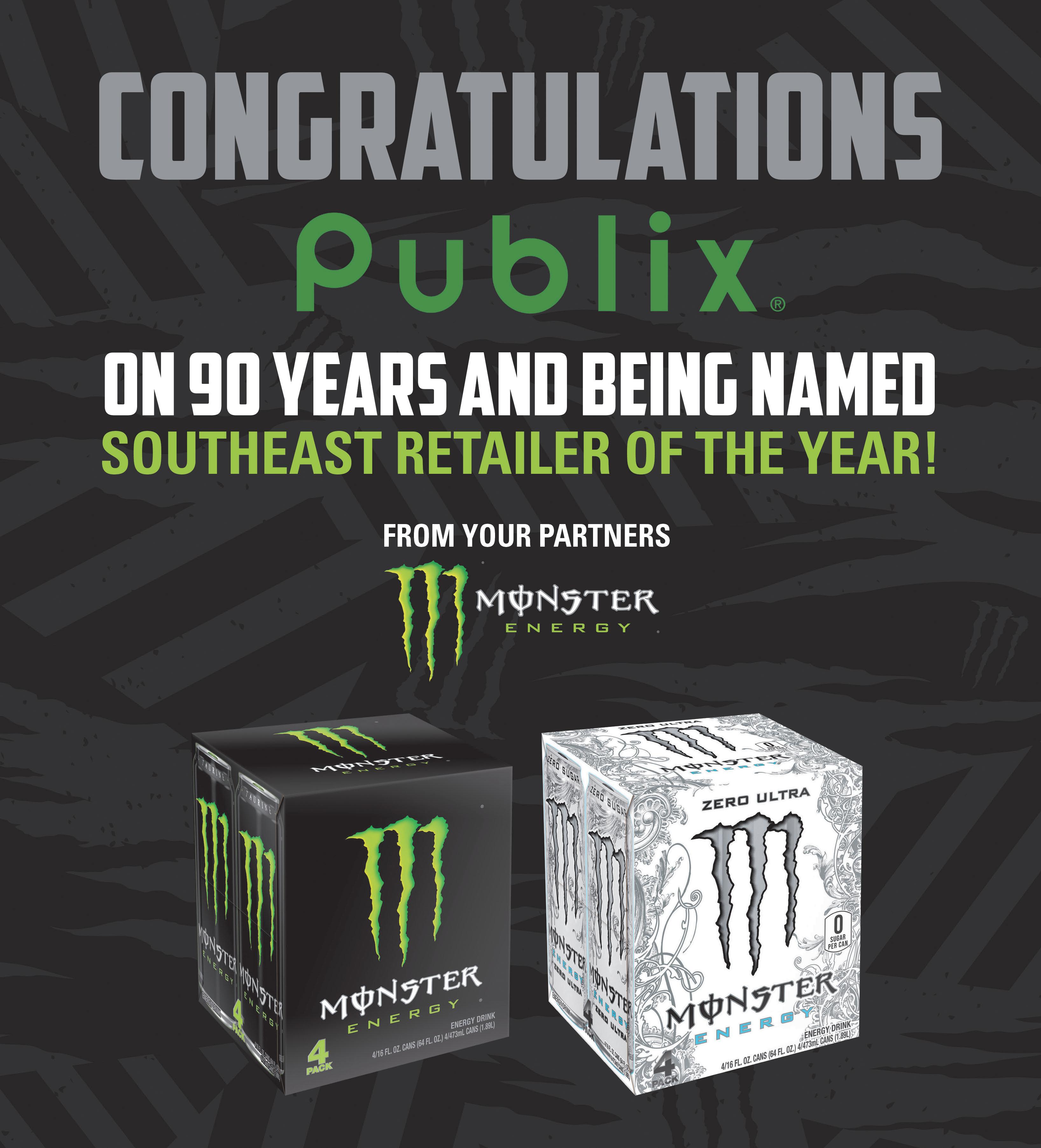
especially during the COVID-19 pandemic.
“When the first Publix store opened 90 years ago, our founder, George Jenkins, instilled a set of values that still guide us today,” said Publix CEO Todd Jones. “Our philosophy has always been to respect the dignity of our associates, treat our customers like royalty and give back to our communities.”

In compiling the list, People magazine partnered with Great Place to Work to analyze surveys of more than 4.8 million employees on their experiences of how their workplaces have made a difference in their lives and their communities.
Rankings also reflect Great Place to Work’s assessment of the generosity of each organization’s benefits and their philanthropic and community support, with particular focus on activities in response to the coronavirus.
Aug. 12
Lakeland, Florida-based Publix has been named United Way’s No. 1 Global Corporate Leader. For more than 40 years, Publix associates have shown their commitment to
improving the early education, financial stability and health and wellness of individuals in the communities Publix serves through donations to the annual United Way campaign.
In 2019, associates pledged $38.6 million to United Way with Publix Super Markets Charities committing another $25 million, bringing the total to $63.6 million. The donation supports 109 local United Ways in Florida, Georgia, Alabama, Tennessee, South Carolina, North Carolina and Virginia.
“We’re honored to be recognized as United Way’s No. 1 Global Corporate Leader,” said Publix CEO Todd Jones. “Our founder, George Jenkins, believed in the benefit of giving to United Way because the funds raised support the critical needs of the community through local agencies. I’m proud of our associates for continuing the legacy of giving Mr. George exemplified.”
“Publix and its associates share United Way’s belief in building strong communities, which is why it’s no surprise to see Publix become our largest corporate donor,” said Brian Gallagher, president and CEO of United Way Worldwide. “On behalf of everyone at United Way, I want to thank Publix for being incredible community citizens.”
Aug. 7
Lakeland, Florida-based Publix has been recognized by Fortune as a great place to work. It ranked No. 69 in Best Workplaces for Millennials for the fifth consecutive year.
Millennials, those born between 1981 and 1997, make up about 40 percent of Publix’s workforce.

The companies that made Fortune’s list were those with favorable ratings on anonymous surveys conducted by Great Place to Work. Millennials were surveyed on their experiences of trust and innovation at their companies, their ability to reach their full potential at
their place of work, company values, effectiveness of their leaders and other factors.
To read what Publix associates have to say about working at Publix, visit its profile on greatplacetowork.com/certified-companies.
Publix CEO Todd Jones chats with an associate during a recent visit to the store in Palmetto, Florida. Attracting, retaining and developing top talent are priorities for Publix. Among its many recent honors, the company was ranked by Forbes as 21st on its list of America’s Best Employers for New Grads 2020. In addition, Fortune rated Publix No. 69 in Best Workplaces for Millennials.
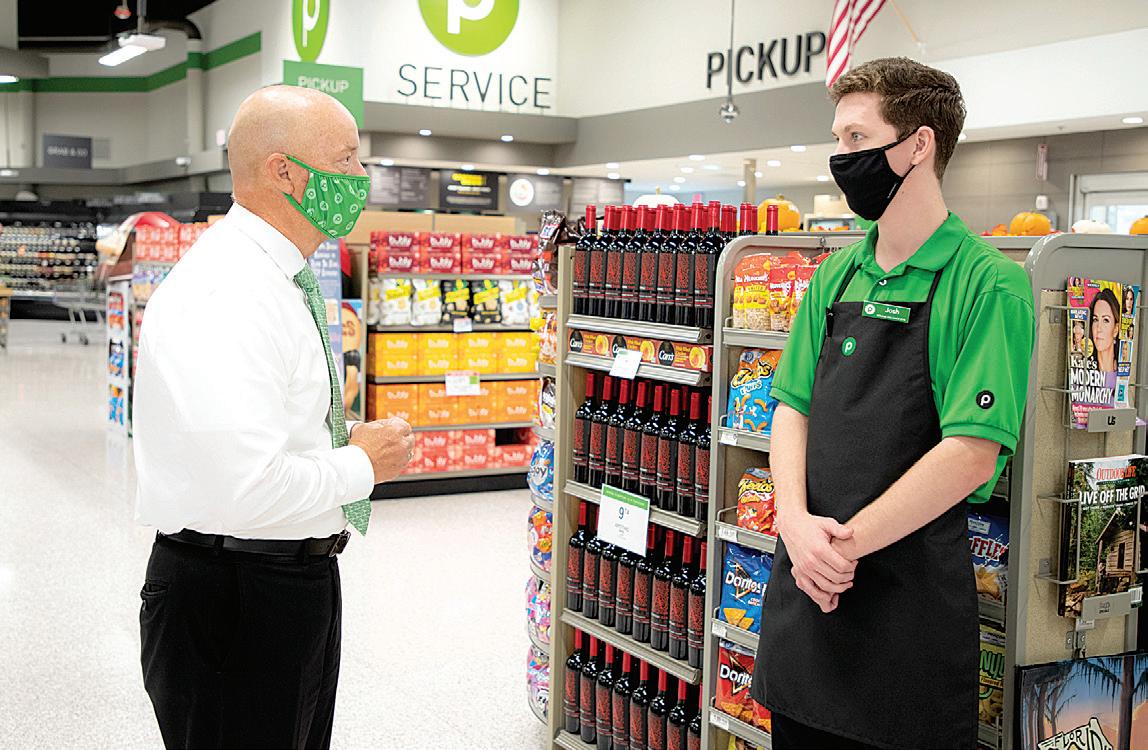

Want to know what makes Publix successful? It’s the people – those who shop there as well as those who work for it.



CEO Todd Jones knows that well. A 40-year employee who started with the company as a bagger, he’s as comfortable on the floor as he is in a boardroom – perhaps more so.
With Publix photographer Brandon Cruz and a team from Shelby Publishing in tow on Oct. 1, Jones led a nearly 90-minute tour of a new concept store in Palmetto, a community east of Sarasota.

Jones began the tour by noting, “There are a couple of things that we have changed since the last store design when you enter the store. We believe in allowing the customer to shop the way that they want to shop, whether they want to come in and shop as a typical shopper inside the store, browsing and doing whatever they want to do. Do they want it delivered? Do they want to pick it up in person?”
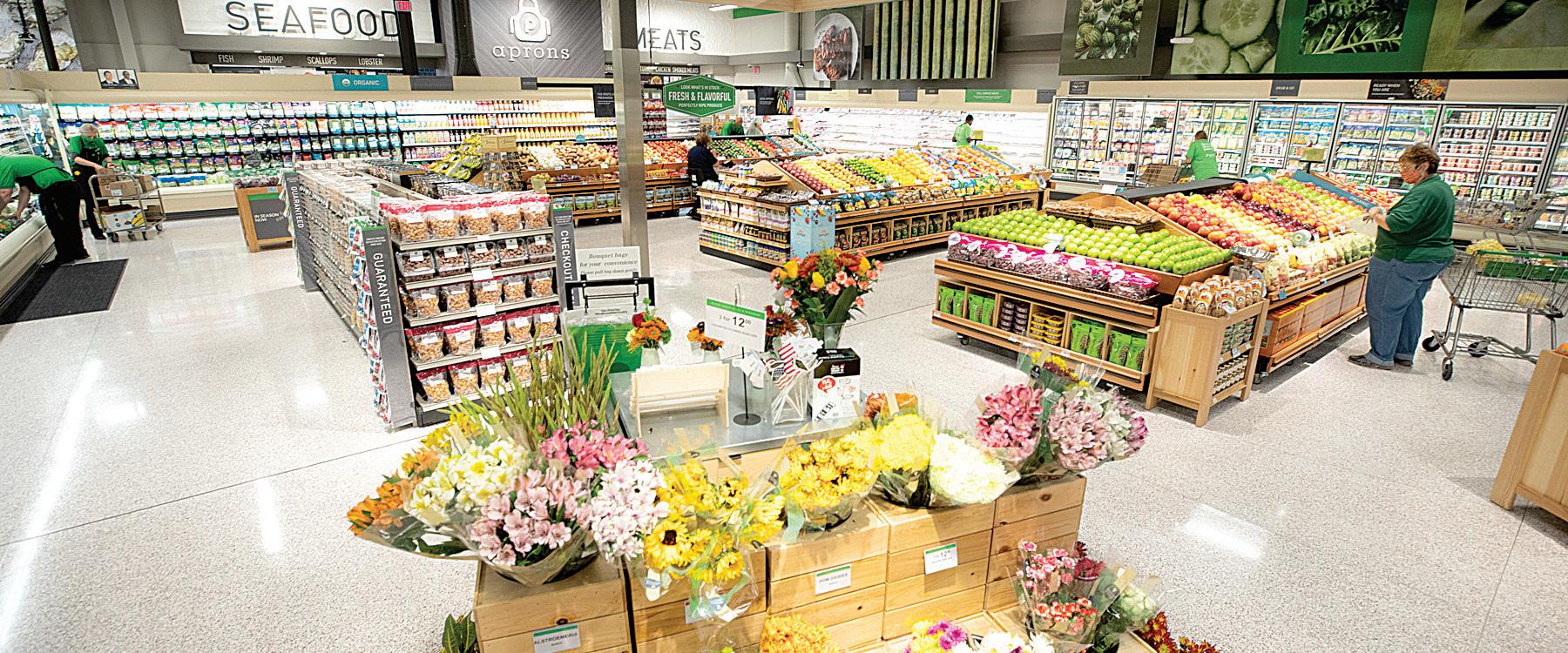



Shoppers need not look far to find the customer service desk, which is located close to the entrance. Said Jones, “We’ve always believed in having [it] front-right or front-front, when you walk in. That way, we have someone who’s going to be here, solving any of those things you may need. There’s nothing that [our customer service] won’t be empowered to be able to make a decision on. We never knowingly disappoint you. If for any reason you are dissatisfied, we will cheerfully respond immediately upon request.”






1930s: In the midst of the Great Depression, George Jenkins walked away from the security of a good job to open the first Publix store in Winter Haven, Florida. This store set not only a new precedent for cleanliness and beauty, but also the Publix standard for employee relations. Mr. George, as he was affectionately called by his associates, established profit sharing and employee ownership. Gross annual sales in the early years averaged about $100,000, slowly rising to $120,000 by 1934.


While many of his competitors’ store shelves went bare for lack of goods, Mr. George traversed the country seeking products to send back home to stock his stores. In his travels, he also garnered ideas about how to better the business.
1940s: In 1940, George Jenkins mortgaged an orange grove he had acquired during the Depression for a down payment on his dream store – Publix’s first supermarket. He built his “food palace” of marble, glass and stucco, and equipped it with innovations never seen before in a grocery store. Air conditioning. Fluorescent lighting. Electric-eye doors. Frozen food cases. Piped-in music. Eight-foot-wide aisles. Open dairy cases designed to Mr. George’s specifications. In-store donut and flower shops. People traveled from miles to shop there, and Publix prospered.

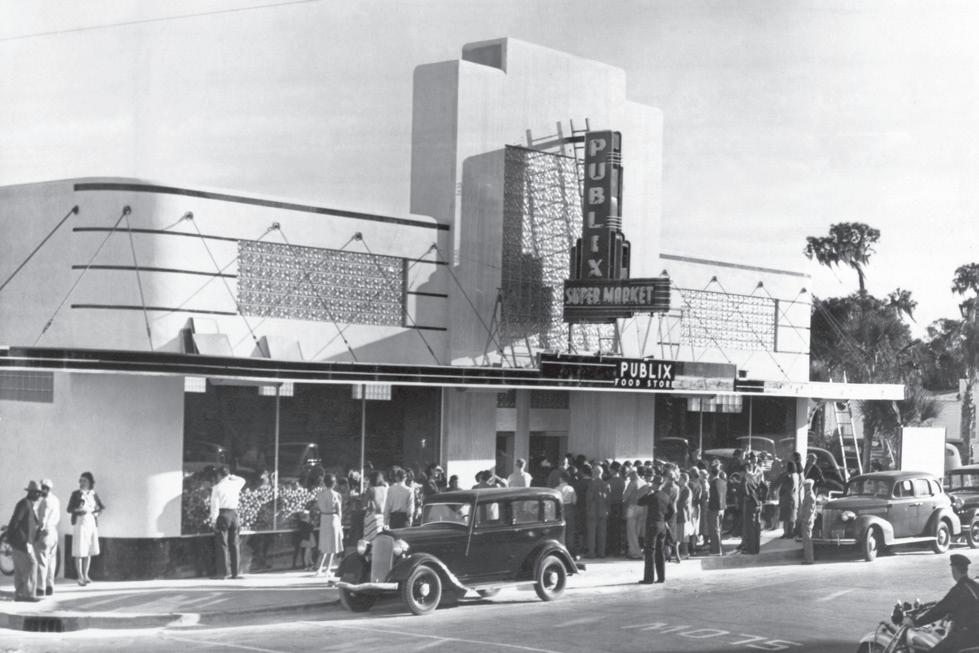
But again, larger forces restricted his plans: the country was at war. In 1945, with construction expansion constrained by wartime shortages, Publix purchased a chain of 19 small, All-American grocery stores.




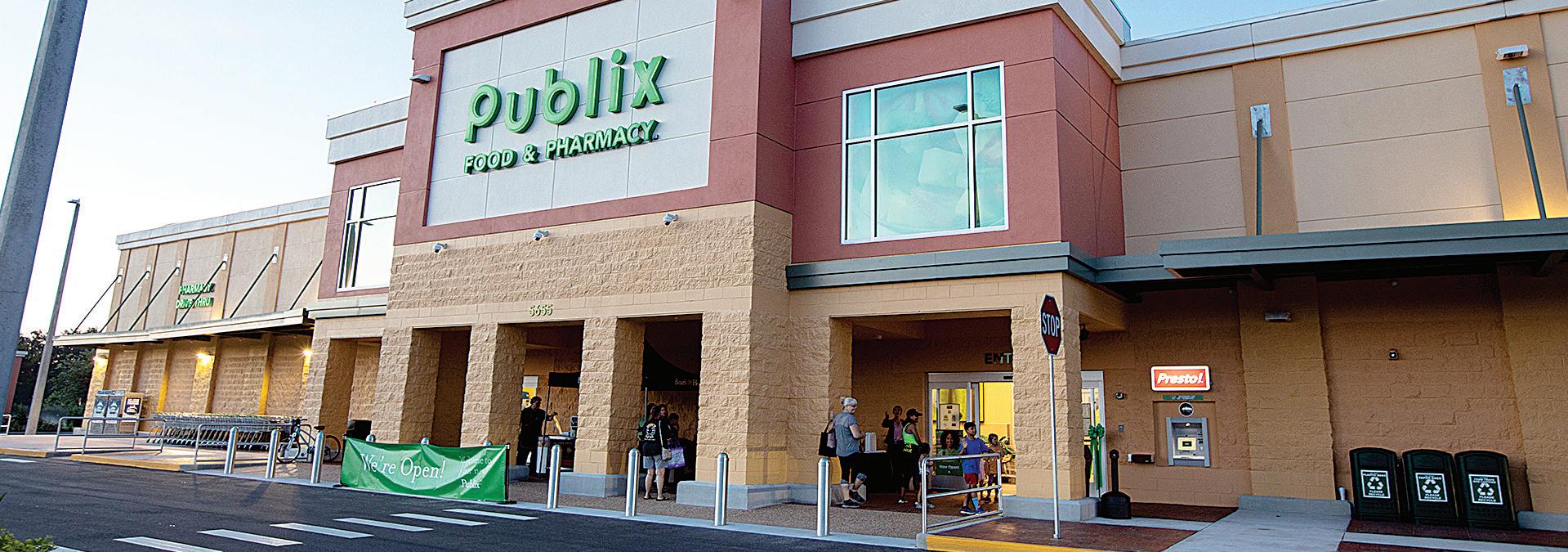
1960s: George Jenkins’ reputation was growing along with the business, and he was elected president of the Super Market Institute in 1961. Profits were likewise fabulous; a share of Publix stock, valued at $2.50 in 1958, was worth $44 by 1969.

1950s: Publix began closing its older stores and replacing them with modern ones. In 1951, to help build and supply the stores, a 125,000-square-foot warehouse and headquarters complex was completed in Lakeland. As the chain grew, so did the Publix spirit, based on the extraordinary policies and attitudes founded in the first store. Sales grew, too. In 1951, the chain’s 24 stores grossed more than $18 million. By 1955, gross sales had increased to $49 million with earnings of $830,504. In 1956, Publix recorded its first million-dollar profit year.

The expansion begun in the ’50s continued at full speed throughout the ’60s, with Publix spending $63.1 million on expansion from 1959-69. In 1962, there were 85 stores. By 1969, there were 150. While the first wave of building focused on central Florida, geographic expansion dominated the ’60s. Publix purchased seven new stores in 1959, mainly in the southeast coast area, to get a foothold in that market.

By 1963, Publix had opened the Miami Division and constructed a 300,000-square-foot distribution center to supply the growing number of stores there. The first Publix Deli also was installed during this era.



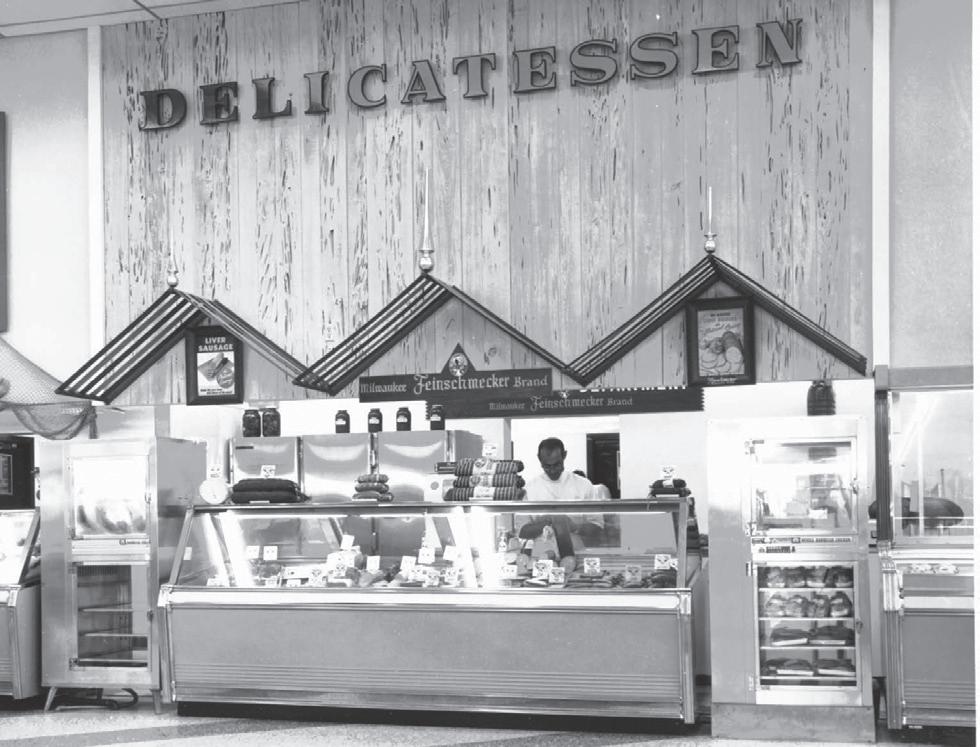




1970s: In 1970, Publix achieved another high mark, recording nearly $500 million in sales – a figure that would double in four short years.Three new stores opened in Jacksonville in the early ’70s, laying the foundation for a new division. A bakery plant and a produce distribution center opened in 1973. Other construction milestones included various distribution centers and storage and distribution facilities.
By 1978, Publix was grossing nearly $2 billion annually, with profits of more than $32 million. Store expansion also continued; 1979 was a record-breaking year with 15 new stores. Publix was spending nearly as much every year for expansion as it did during the entire previous decade.
By the end of the ’40s, the small chain of stores Publix bought and refurbished had fulfilled their mission by launching the Publix chain. With peace came new prosperity. Now, at last, George Jenkins could fulfill his dream to build a chain of stores as fine as that first Publix Super Market.
1980s: Publix turned 50 in 1980 and celebrated by kicking off a decade of technological innovation. In keeping with the company’s penchant for using technology to make shopping more pleasurable, Publix introduced checkout scanning statewide.

More innovation came in 1982 with the launch of the Presto! ATM network. In the mid-’80s, the Lakeland deli plant began production, and an Orlando store pioneered the first Publix pharmacy. Scores of distribution centers and processing plants opened around the state, and by the end of the ’80s, Publix had 367 stores and 64,000 employees. In 1989, total revenues were $5.4 billion.
1990s: 1991 saw a milestone in Publix history when the company crossed the state line to open a store in Savannah, Georgia. The Atlanta Division soon followed. The ensuing years were filled with accolades. In 1993, the book, “The 100 Best Companies to Work for in America,” named Publix in its top 10. Publix consistently receives local and national recognition as tops in the grocery business for superior quality and customer service.
2000s: In 2005, sales surpassed $20 billion. In 2007, Publix began its free oral antibiotic program, and a few months later filled its 1 millionth free prescription.

In 2002, Publix expanded to its fifth state by opening stores in Franklin and Hermitage, Tennessee.
In 2008, Todd Jones became Publix’s sixth president, and the following year, Publix opened its 1,000th store.
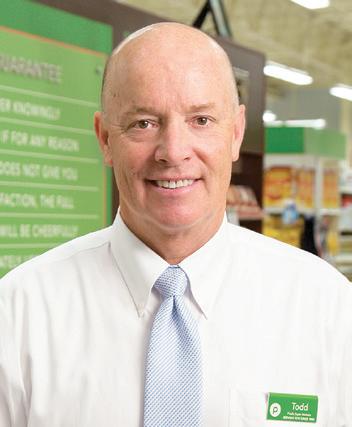
This also was a decade of evolution, as Howard M. Jenkins assumed the roles of CEO and Chairman of the Board.
In 1993, Publix opened its first store in South Carolina. The following year, the Florida Commission on the Status of Women honored Publix for progress in programs that support women. In 1995, Fortune magazine ranked Publix the 29th most admired company nationwide, and Publix made Fortune’s Famous 500 and Global 500 lists.





Business continued to boom, and in 1996, Publix began doing business in Alabama. Also in 1996, George Jenkins passed away. His spirit, however, lives on in Publix associates.
The Aprons Simple Meals program rolled out to all stores. During this time, Publix introduced several specialty formats: Aprons Cooking Schools, Publix Liquors, Hispanic-themed Sabor stores and Publix GreenWise Market natural food stores.
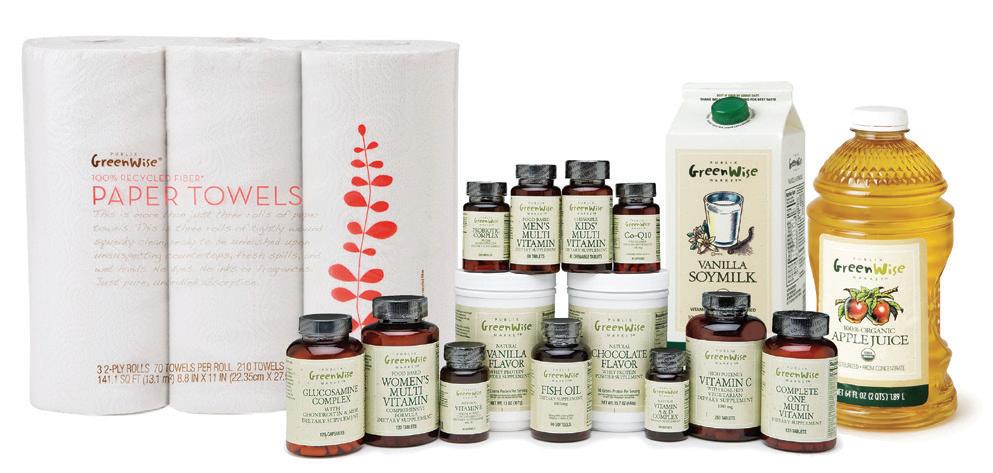

The first North Carolina store opened in Charlotte on February 2, 2014.


Publix moved into Virginia when the first store opened in Glen Allen on July 15, 2017.
2010s: Like Mr. George, CEO Todd Jones makes time to visit stores to talk with associates and serve customers.
In 2012, Publix announced its expansion to North Carolina, and the first stores opened in the Greater Charlotte area in 2014.

Publix celebrated its 85th anniversary in 2015. In 2016, Publix began offering grocery delivery through a partnership with Instacart, making shopping both more convenient and accessible for our customers’ busier lifestyles.



The first new-format GreenWise Market opened in Tallahassee, Florida, on Oct. 4, 2018. GreenWise Market features specialty, natural and organic products organized in “experience zones” throughout the store. There are currently a number of GreenWise Markets, including one in Lakeland.

In 2019, Publix opened an innovation lab called the Green House. This lab provides the space needed to test concepts and new ideas before they roll into stores.

The Publix Facebook account went live on July 1, 2011. The first official post reads, “You’ve been asking, and we’ve listened. We’re happy to be part of the Facebook family. We can’t wait to hear from you.” Publix Instagram and Pinterest accounts came later in 2015.

Jones pointed out that Publix lets its store teams have creativity in their merchandising. “We give them a lobby space to allow them to bring a theme to life,” he said. “Whether it’s Halloween or a football theme, we give them this area to work with and they have the creativity and wherewithal to decide where to put it. That way, if they’re in Alabama, or they’re in the [Florida] Keys, or in South Carolina, they can bring that to life. It’s better for them versus us saying, ‘Hey, you need to put this product here.’”





“What we have done is we’ve repositioned the deli to be more on the front-right for the consumer that’s looking for that convenience,” Jones explained as the tour continued. “Also, we believe the customer now has really embraced our [grab-and-go] customer program, so we’ve actually co-mingled it next to the deli items. That might be something you would want for lunch to take home, or maybe for dinner instead.”
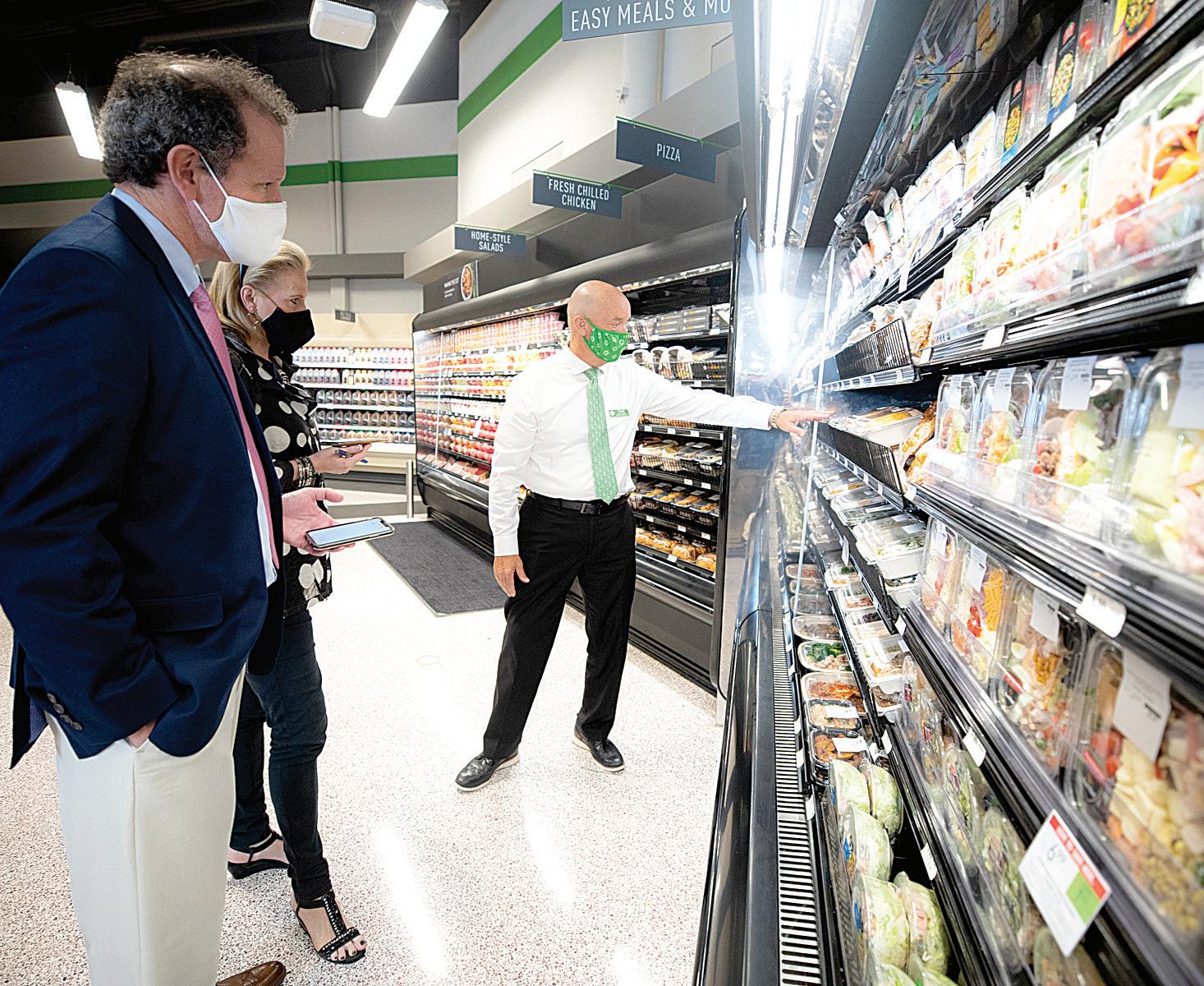




Transitioning from the deli, Jones said the same approach is evident in other departments. “We want to make sure that the lighting and the environment – the things that are in the store that complement and make the product for the people – are the star of the show.” He added that environmental cues could vary, ranging from lighting and signage to messaging and uniforms. “It’s important that we continue to carry that vision going forward – that we use it to help us understand when we walk stores that there are three or four legs to the stool.”



From your friends at Congratulations
on 90 Years of



The Publix in Palmetto features more closed product cases than open ones. According to Jones, the purpose is twofold: “No. 1, it does keep the product integrity a little bit better. The temperature is more controlled. [Also] we’re really working on continuing to reduce the amount of energy that our stores need to help the environment long term…we’ve actually put doors on multiple places throughout our departments.”


And the cases have been well-received by customers. “All of our stores now, it’s not about the minimum standard. It’s about the right standard for the customer. And that’s based off of listening to them, watching the shopping habits, the frequency of when they shop certain departments and what time of day.”


“We continue to make sure that we’re operating our business for the customer, whether it’s the front or the back of the house,” Jones said. One area of emphasis is store layout, ensuring a smooth transition for shoppers. “A lot of synergies here for the consumer, making sure those transitions work really well…making sure they’re also producing product at a standard. Again, it’s important for our customers to make sure that we’ve done all the hard lifting…and we’ll try to leave as little lifting as possible once [they] get home.”




At Publix, all of the red meat and pork cuts, as well as grinds, are prepared in store. “We want to make sure that customers can easily look and say, ‘I’d know what to do with that,’” Jones said. “Stir fry should be cut the exact same, it should be shingled – so that the customer can see what they’re doing – and not just packed in there.”




He continued, noting that Publix also offers a large selection of value-added meals. The goal is to “take a little bit of the work out for the customer…maybe they just want to top it off and finish it.” Ready-to-go items include: marinated kababs; stuffed hamburgers, pork and chicken; pinwheels; crusted chicken tenders; and marinated fajitas.
From your Friends at

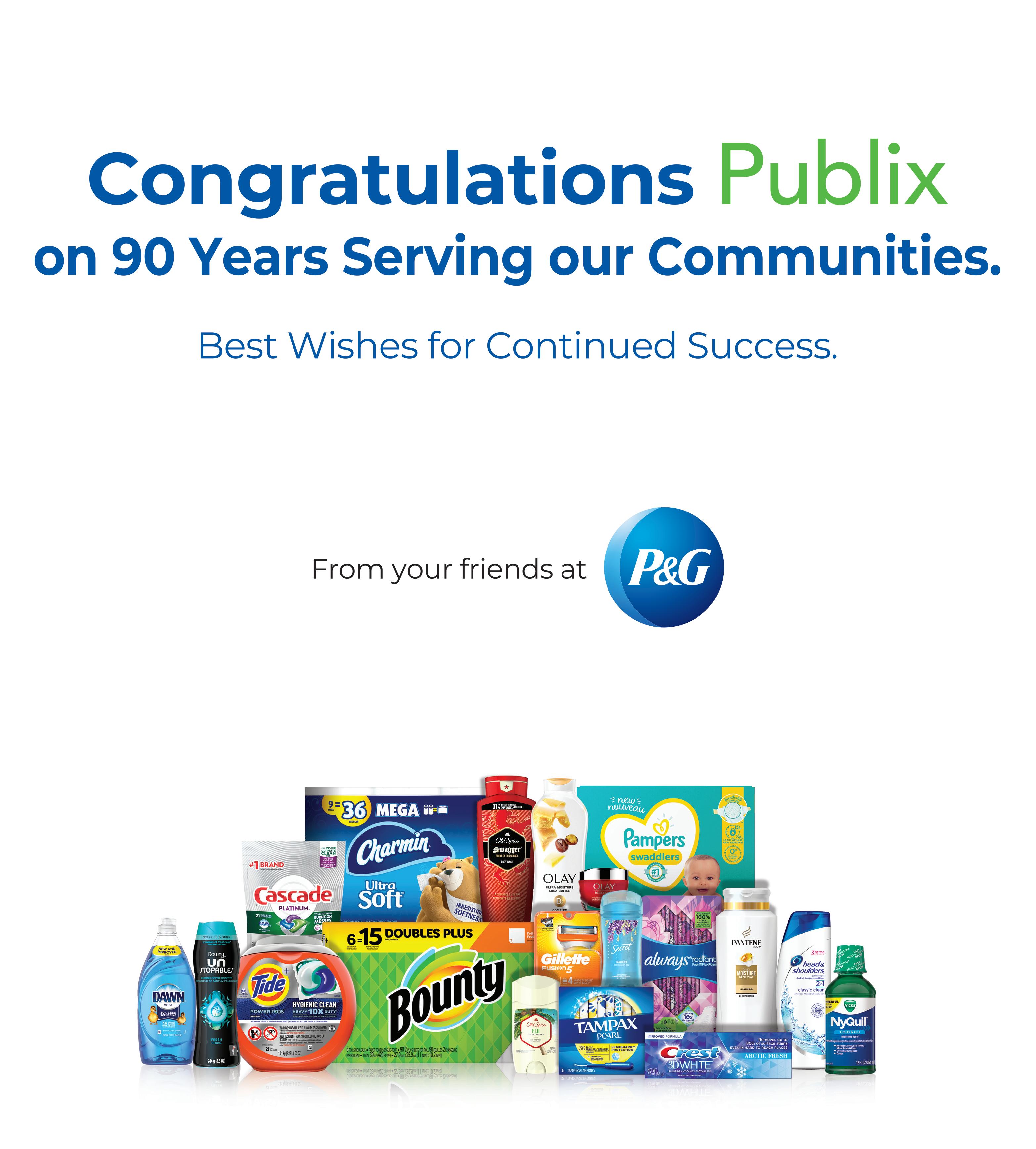
Jones visits with members of the management team at the store in Palmetto. Publix is known as a great place to work, with many managers having risen through the ranks. “Some take the channel of grocery, some take the channel of produce, some go to the meat department,” Jones said. “They come back in as assistant store managers and go back across all the departments to learn those other departments to become a store manager to lead the store. It really helps them out long term.”

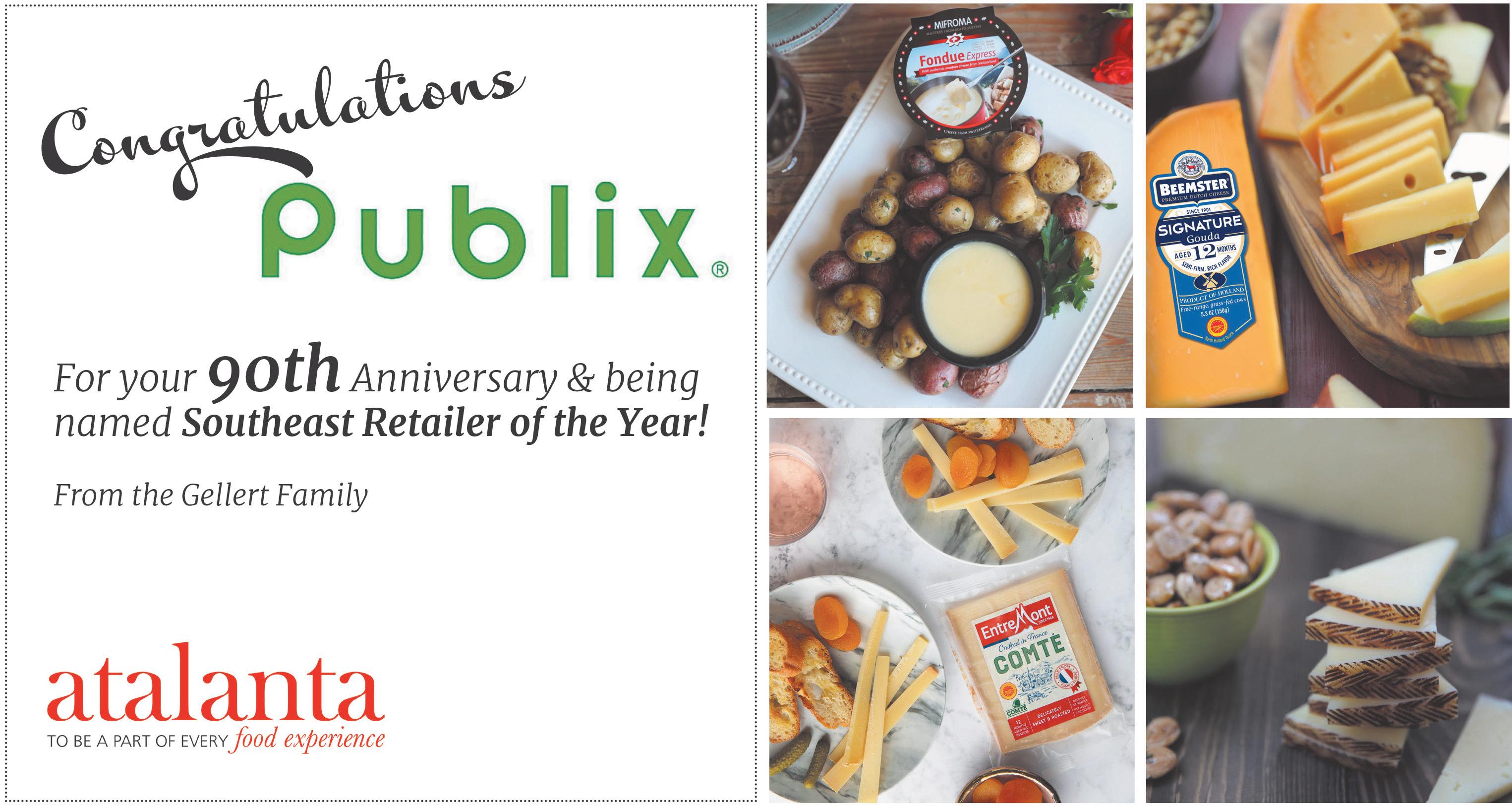

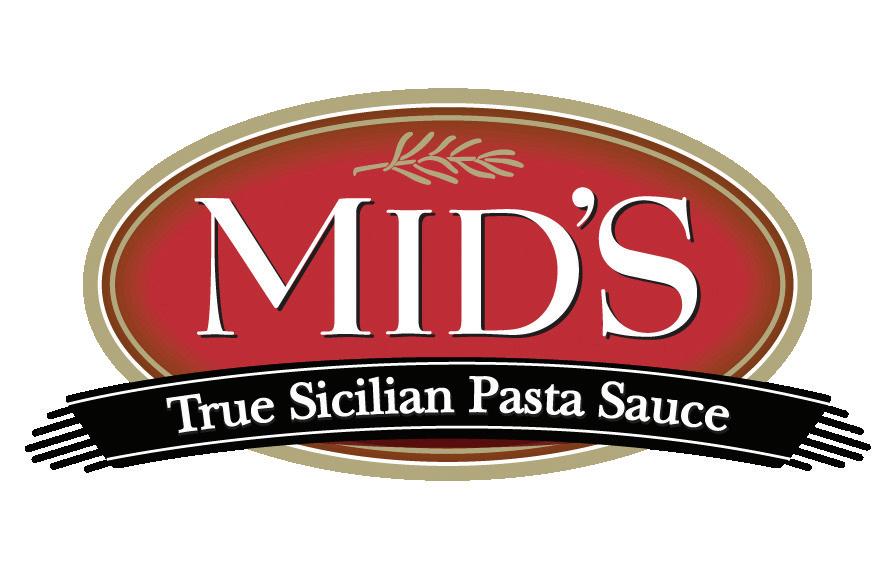

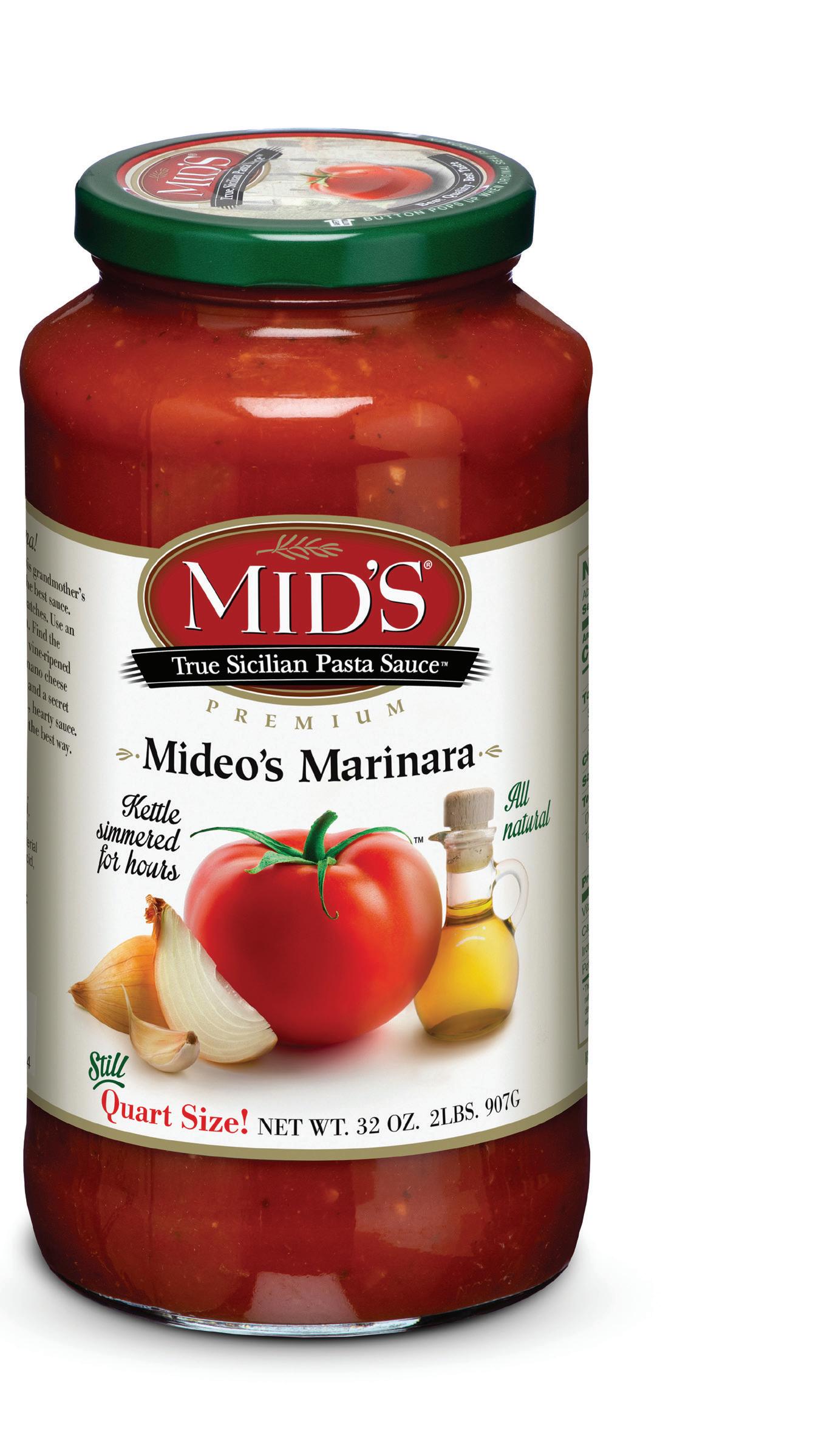
For 90 Years of Success & 2020 Southeast Retailer of The Year!

Jones acknowledged that the supply chain is still a bit disrupted, with some partners having to SKU rationalize.


“We’re getting better – much better than we were a week ago, if not where we were six months ago,” he said. “We need to make sure that we’re collaborating on ads and things that are going to create more demand on product. If you just start to get that product back in the case, and then all of a sudden you put a product in ads, you burn through it a little bit quicker than you anticipated with the forecast… so we’ve got to be good at that as well.”


Stopping in at the bakery, where most of the baking is done in-house, Jones pointed to scratch-made bread, desserts and cakes. He then marveled at the complexity of the operation. “To get a loaf of bread with the right crust on it, the right size consistently… this is a lot of work. That’s an out-of-this-world product.”




Exploring the bakery, Jones pointed to the array of cakes made daily on site. The process takes about four hours, from mixing to “ready to show.” He also shared the story behind one of its increasingly popular items, Chantilly cake. “One of our decorators came up with that out in the [Florida] Panhandle, and sent it in as an idea. It’s been a really good product for Publix.” The fan-favorite French hamburger buns might be the most challenging dough. Per Jones, “They’re made consistently every single day to come out exactly right… it has to be cut and scoured on the top, so the top of it’s just right. It’s the most unique hamburger bun you could have.”





As the conversation turned to holidays, Jones said families may have smaller, more frequent meals.
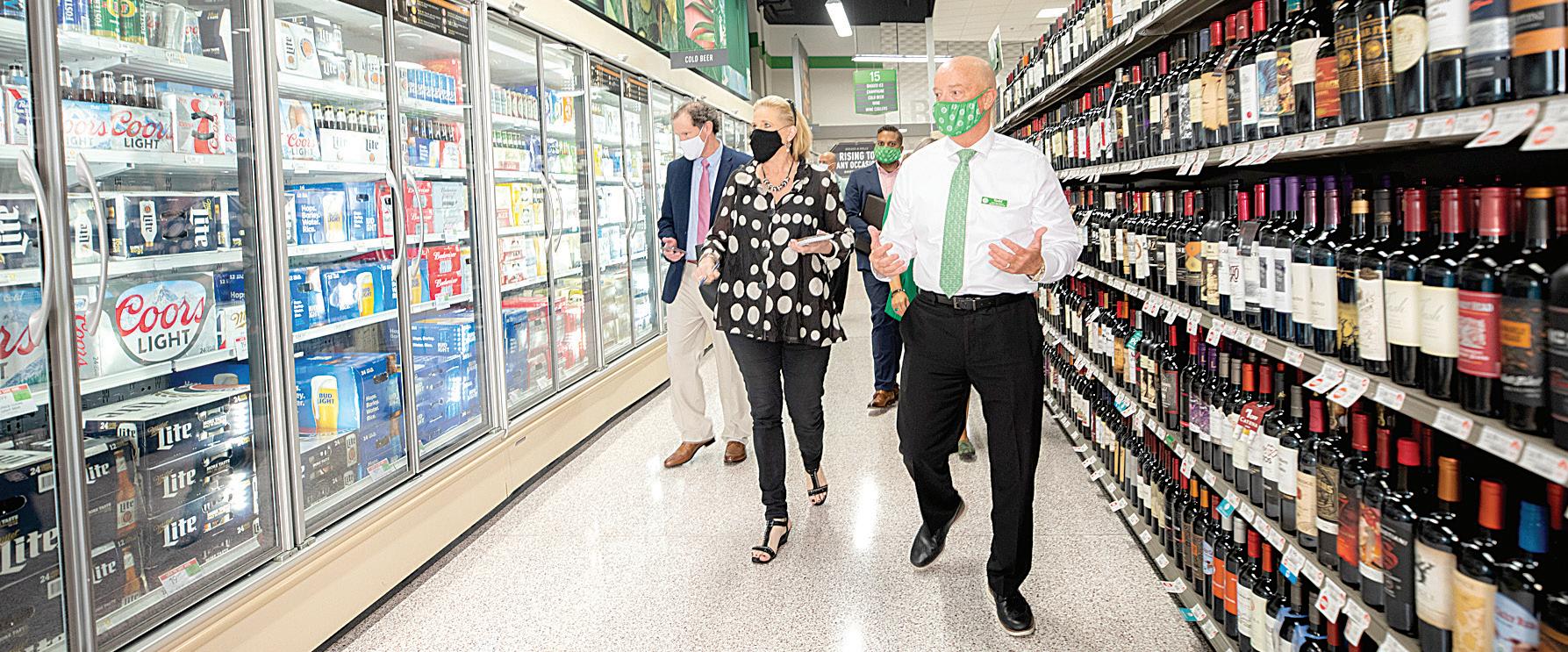

“We’ll make sure that we’ve got the small, the medium and the large birds [at Thanksgiving] for the customer to try to help solve their needs, whether it’s fresh or frozen. I think we’re banking on the fact that it will be fairly traditional. I think we’re at a point where people are a little more comfortable with their family gathering together. Platters – I’m a little more concerned with, particularly for Christmas and New Year’s.”


“They do a wonderful job,” Jones said of Publix pharmacists.



“To understand what these folks have to deal with – the interactions with another drug that a customer may be on, the foods they may be eating – they are just a wonderful source of knowledge for customers. They do a fantastic job of helping them navigate their wellness as they move forward in their lives. I can’t brag on these people enough. And we try to make it as convenient as possible. The drive-thru is important. If you’re not feeling well, or your child’s not feeling well, you don’t have to drag them in here.”


As the tour neared an end, Jones pointed out the selfcheckout stations. Although the company prides itself on face-toface customer service, it also wants to serve shoppers the way they want to be served, and there are “customers that believe this is service. They just won’t let it impact having a register open for their convenience. This way, we allow the customer to shop the way they choose to shop.” He added that the service is expanding. “All of our new stores will have it. And then when we do a remodel, all stores will get it.”
Messaging also is a key for Publix, which uses it as a tool to help customers navigate, whether that’s products, organic or the Better Choices program.


“Better Choices is the better product for that particular category,” Jones explained. “If you’re over in the cereal aisle, it might be less sugar content…maybe in the soups, it’s less sodium. It depends on the category. It’s not the same everywhere. That way, the customer can at least know, if I’m going to have pasta sauce, this one is a better choice. The sodium is less, the saturated fats are zero, and the sugars are low.”







